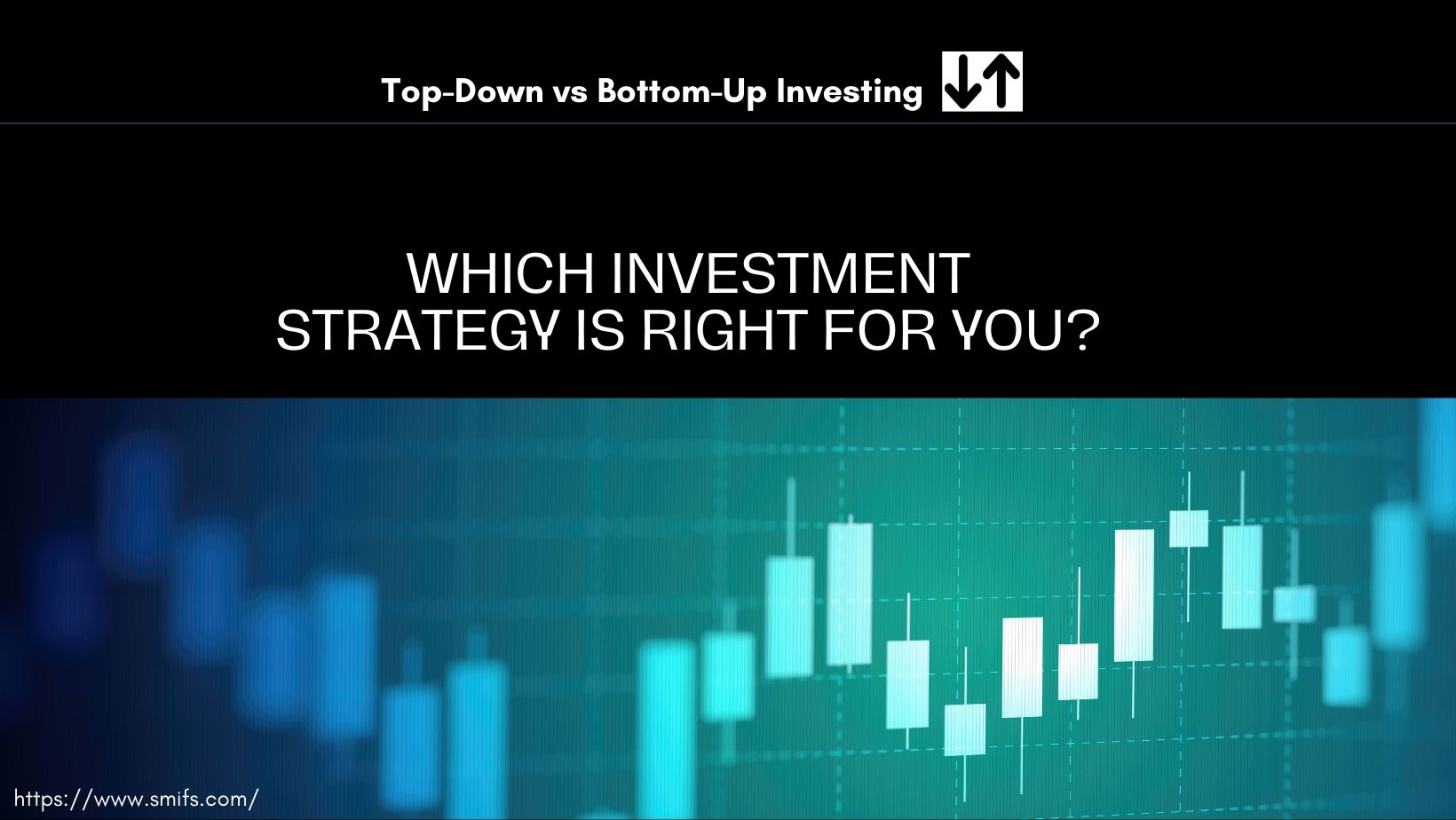Top-down vs bottom-up approach users have always been in conflict with each other. Using a variety of investment analysis techniques is one of the keys to managing your investment portfolio properly. To estimate an asset’s future performance, you can assess a variety of assets and securities, as well as industries, trends, and sectors, using investment analysis. By doing this, you can determine how well it aligns with your investment objectives. These two approaches are known as bottom-up and top-down investing, respectively.
While bottom-up investing considers company-specific aspects like financials, supply and demand, and the kinds of goods and services a firm offers, top-down investing bases investment decisions on broad economic issues. Both strategies have benefits, but they all aim to achieve the same thing, i.e., to identify the best stocks.
In this blog, we will try to understand both methods.
What is top-down investing?
Top-down investing considers factors at the national, market, or macroeconomic levels. It can be compared to the bottom-up strategy, which places more focus on a company’s fundamentals first before moving up the structural hierarchy and, if at all, looking at macroeconomic global variables last. Macroeconomic variables—such as GDP, trade balances, currency fluctuations, inflation, interest rates, and other economic factors—are used by investors to get a broader view of the market.
Analysts first consider global macroeconomic conditions and then turn their attention to general market conditions to pinpoint high-performing sectors, industries, or geographic areas. The objective is to identify certain industry sectors with forecasted performance above the market.
Rather than placing their money on individual enterprises, top-down investors use these characteristics to direct their investments towards economically successful regions. An investor may choose to move their assets overseas by buying exchange-traded funds (ETFs) that follow particular Asian nations, for instance, if economic development in Asia exceeds domestic growth in the United States. From this vantage point, they can go deeper into certain businesses to identify those that could be lucrative investments by focusing last on their fundamentals.
By examining broad economic aggregates before focusing on particular industries, regions, and firms, top-down investing can optimise an investor’s time more effectively than starting with the full range of stocks from each company. But by excluding certain businesses that perform better than the market as a whole, it can also lose out on a significant amount of potentially lucrative opportunities.
What is bottom-up investing?
In this approach, you begin by researching the company and then go on to locate the rest of the data.
The goal of the bottom-up strategy is to examine the company’s fundamentals independent of macroeconomic, industry, or market situations. When employing the bottom-up strategy, investors examine the company’s revenues, earnings, financial ratios, products and services, sales growth, management, and other aspects to determine how fundamentally sound it is.
In this case, identifying a potentially strong company that can outperform the market and industry in the future is essential. Regardless of market movements, bottom-up investors will choose businesses with solid fundamentals for their investments. The primary benefit of the bottom-up method is in its ability to help investors identify the most robust firm that can outperform, even in the event of a downturn in the economy or industry. The bottom-up approach helps in picking quality stocks.
Conversely, a drawback of the bottom-up strategy is that investors may make biased investment decisions according to their preconceived notions about the company. Additionally, some investment returns may suffer as a result of these investors’ disregard for the market’s circumstances and the longer-term economic impact.
Top-down and bottom-up are entirely different approaches to analysing and investing in stocks. However, both have their advantages and disadvantages.
The top-down approach first looks at the broader economy and macroeconomic factors and then moves to the specific industry and the company within. On the other hand, the bottom-up approach starts at the company level and later moves up to the other important details.
In general, a top-down approach can be a little easier for less experienced investors as they do not have to perform the intense stock research and analysis. They can start studying the most appealing industry and find the companies within which to invest.
Anyway, both approaches have their effectiveness, and hence, it is difficult to say which one is better. Moreover, it also depends on the knowledge and preferences of the investor. My final advice would be to try out both approaches and find out which one suits you the best for your investment strategy.
Top-down vs bottom-up approach? Is one better than the other?
The answer to this question is not definitive. Your investing objectives, risk tolerance, and preferred analysis style will all play a major role in selecting the right one for you. You have two options: either utilize one or think about using a hybrid approach, which involves using parts of both approaches to develop and manage your portfolio. If you want to realign your portfolio, you might begin with a top-down strategy and subsequently go to a bottom-up style of investing. There are no right or wrong ways to go about doing things. It’s all about what feels right for you, as was previously noted.
Less-seasoned investors may find the top-down strategy easier overall because it spares them from having to conduct extensive stock research and analysis. They can begin researching the most desirable sector of the economy to identify potential investment opportunities.
In any case, it is hard to determine which strategy is superior because each has its own unique efficacy. Furthermore, the investor’s expertise and preferences also play a role. Finally, we would advise you to test out both strategies to determine which works best for your investing plan.
Thereafter, we can conclude that a top-down strategy starts with the overall economy, examines the macroeconomic variables, and focuses on certain industries that do well concerning the overall economy. Subsequently, the investor operating top-down chooses businesses inside the sector. In contrast, a bottom-up strategy selects the business with the most promising prospects based on more microeconomic considerations by examining the qualitative and fundamental metrics of several organisations. When creating a well-balanced investment portfolio, both strategies have merit and ought to be taken into account.




